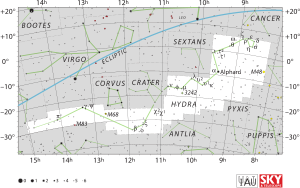Hydra: Difference between revisions
From All Skies Encyclopaedia
(created the page (first draft)) |
(→Origin of Constellation: added double clay tablet) |
||
| (2 intermediate revisions by the same user not shown) | |||
| Line 5: | Line 5: | ||
The Greek constellation of the Water Snake is a derivative of the Babylonian constellation of the MUŠ-Dragon, a dog-headed creature with the body of a gigantic snake with front legs and wings. |
The Greek constellation of the Water Snake is a derivative of the Babylonian constellation of the MUŠ-Dragon, a dog-headed creature with the body of a gigantic snake with front legs and wings. |
||
=== Origin of Constellation === |
=== Origin of Constellation === |
||
The Babylonian constellation is mentioned ... |
|||
Aratus |
|||
Hipparchus mentions the constellation rising and setting. The first star rising is , the last star rising is the oneat the tip of the tail (ὁ ἐν ἄκρᾳ τῇ οὐρᾷ) |
|||
=== Almagest === |
|||
=== Transfer and Transformation of the Constellation === |
=== Transfer and Transformation of the Constellation === |
||
| Line 10: | Line 17: | ||
File:Hya+crt+crv stellarium mulapin.jpg|the Babylonian version of the "Hydra and Corvus" super-constellation does not contain a cup or jar. visualized in Stellarium (drawing by Jessica Gullberg) |
File:Hya+crt+crv stellarium mulapin.jpg|the Babylonian version of the "Hydra and Corvus" super-constellation does not contain a cup or jar. visualized in Stellarium (drawing by Jessica Gullberg) |
||
File:Cnc Hya KAKSISA stellarium.jpg|the lonely star in front of the dragon-head (Procyon) rised simultaneously with the faint stars of The Crab in ancient Babylon. Procyon and the head / foot of the dragon may serve as a replacement for Cancer |
File:Cnc Hya KAKSISA stellarium.jpg|the lonely star in front of the dragon-head (Procyon) rised simultaneously with the faint stars of The Crab in ancient Babylon. Procyon and the head / foot of the dragon may serve as a replacement for Cancer |
||
File:Leo+vir umzeichng4plani black.png|Leo and Virgo above the MUŠ-Dragon, two claytablet drawings from the Seleucid era (roughly 2nd century BCE), CC BY SMH based upon the drawings by E. Weidner (1967) and Thureau-Dangin (1922). |
|||
File:Hya+crt+crv stellarium farnese.jpg|The Greeks introduced a Crater atop the snake. On the Farnese Globe, the body of the snake forms a vessel for Corvus and Crater. |
File:Hya+crt+crv stellarium farnese.jpg|The Greeks introduced a Crater atop the snake. On the Farnese Globe, the body of the snake forms a vessel for Corvus and Crater. |
||
File:Sidney Hall - Urania's Mirror - Noctua, Corvus, Crater, Sextans Uraniæ, Hydra, Felis, Lupus, Centaurus, Antlia Pneumatica, Argo Navis, and Pyxis Nautica.jpg|In early modern time, some scholars extended the snake-body of Hydra beyond pi Hydrae and placed a second bird ([[Solitaire]] or [[Noctua]]) at this new end. |
File:Sidney Hall - Urania's Mirror - Noctua, Corvus, Crater, Sextans Uraniæ, Hydra, Felis, Lupus, Centaurus, Antlia Pneumatica, Argo Navis, and Pyxis Nautica.jpg|In early modern time, some scholars extended the snake-body of Hydra beyond pi Hydrae and placed a second bird ([[Solitaire]] or [[Noctua]]) at this new end. |
||
</gallery> |
</gallery> |
||
| Line 20: | Line 28: | ||
=== Babylonian belief === |
=== Babylonian belief === |
||
== |
== IAU WGSN == |
||
The star pi Hydrae is very important in history as it is one of the keywitnesses for transfer from Hipparchus to Ptolemy. |
|||
* name in Hipparchus: ὁ ἐν ἄκρᾳ τῇ οὐρᾷ (the one at the farthest point of the tail) |
|||
* name in the Almagest: ὁ ἐπ᾽ἄκρας τῆς οὐρᾶς (the one at the end of the tail) |
|||
The Greek term ἄκρᾳ can be translated as "at the farthest point" or "at the end" (or "hightest" which doesn't apply here). |
|||
== Weblink == |
|||
* |
* |
||
Latest revision as of 05:50, 30 October 2024
One of the 88 IAU constellations.
Etymology and History
The Greek constellation of the Water Snake is a derivative of the Babylonian constellation of the MUŠ-Dragon, a dog-headed creature with the body of a gigantic snake with front legs and wings.
Origin of Constellation
The Babylonian constellation is mentioned ...
Aratus
Hipparchus mentions the constellation rising and setting. The first star rising is , the last star rising is the oneat the tip of the tail (ὁ ἐν ἄκρᾳ τῇ οὐρᾷ)
Almagest
Transfer and Transformation of the Constellation
Mythology
Greek/ Greco-Roman folklore
Babylonian belief
IAU WGSN
The star pi Hydrae is very important in history as it is one of the keywitnesses for transfer from Hipparchus to Ptolemy.
- name in Hipparchus: ὁ ἐν ἄκρᾳ τῇ οὐρᾷ (the one at the farthest point of the tail)
- name in the Almagest: ὁ ἐπ᾽ἄκρας τῆς οὐρᾶς (the one at the end of the tail)
The Greek term ἄκρᾳ can be translated as "at the farthest point" or "at the end" (or "hightest" which doesn't apply here).



